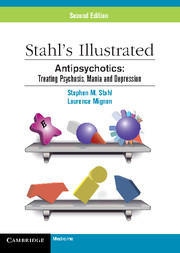Book contents
- Frontmatter
- Preface
- Contents
- CME Information
- Objectives
- Chapter 1 Neurobiology of Schizophrenia and Mood Disorders
- Chapter 2 Multifunctionality of Antipsychotics
- Chapter 3 Side Effects of Antipsychotics: Metabolic Issues and Sedation
- Chapter 4 Individual Antipsychotic Drugs
- Chapter 5 Schizophrenia Pharmacy and Switching Strategies
- Summary
- Abbreviations and Symbols
- Suggested Reading
- Index
- Continuing Medical Education Posttest
- Activity Evaluation
Chapter 3 - Side Effects of Antipsychotics: Metabolic Issues and Sedation
Published online by Cambridge University Press: 19 October 2021
- Frontmatter
- Preface
- Contents
- CME Information
- Objectives
- Chapter 1 Neurobiology of Schizophrenia and Mood Disorders
- Chapter 2 Multifunctionality of Antipsychotics
- Chapter 3 Side Effects of Antipsychotics: Metabolic Issues and Sedation
- Chapter 4 Individual Antipsychotic Drugs
- Chapter 5 Schizophrenia Pharmacy and Switching Strategies
- Summary
- Abbreviations and Symbols
- Suggested Reading
- Index
- Continuing Medical Education Posttest
- Activity Evaluation
Summary
This chapter will go over the metabolic issues and other side effects associated with the different classes of antipsychotics, and explain how an informed psychopharmacologist can ascertain that side effects are minimized and optimal treatment is maximized. Whereas Chapter 4 will expand upon the effects that antipsychotics have on the brain—or the pharmacodynamics of antipsychotics—this chapter includes a section that explains the pharmacokinetics of antipsychotics, namely how brain and body interactions affect the drugs. These are important concepts to understand in order to maximize treatment and minimize side effects.
Specifically, 5HT2C and H1 antagonism is linked to weight gain, and M3 receptor antagonism can alter insulin regulation. Receptor “X” may increase insulin resistance, resulting in elevated fasting plasma triglyceride levels. Some patients might be more prone than others to experience increased cardiometabolic risk on certain atypical antipsychotics.
When hyperinsulinemia leads to pancreatic beta cell failure, pre-diabetes and then diabetes ensue. The presence of diabetes increases a patient's risk for cardiovascular events and premature death.
When patients have dyslipidemia, are pre-diabetic or diabetic, or are obese, it is necessary to obtain their fasting glucose levels, blood pressure, and waist circumference measurements just before starting treatment with antipsychotics and throughout treatment. It may be best in these patients to avoid or switch from antipsychotics that exhibit a higher risk of cardiometabolic side effects.
If, on the other hand, blockade of 5HT and DA receptors has antimanic and antipsychotic efficacy, thus leading to good patient outcome, it would be best to use an antipsychotic that has a 5HT/DA profile, but lacks efficacy at M1, H1, or alpha 1 receptors.
Other patients might become tolerant to the sedating side effects of their medication. Careful monitoring to develop individualized treatment is necessary in determining the best possible treatment plan for each patient.
Various antidepressants such as paroxetine, fluoxetine, duloxetine, and high doses of sertraline are inhibitors of cytochrome P450 2D6; thus they could theoretically raise the levels of the previously mentioned antipsychotics as these are substrates for the same enzyme. However, this is not usually clinically significant.
- Type
- Chapter
- Information
- Stahl's Illustrated AntipsychoticsTreating Psychosis, Mania and Depression, pp. 89 - 108Publisher: Cambridge University PressPrint publication year: 2010



